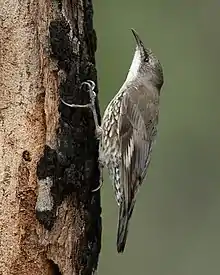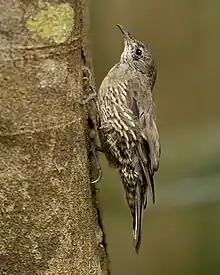White-throated treecreeper
The white-throated treecreeper (Cormobates leucophaea) is an Australian treecreeper found in the forests of eastern Australia. It is unrelated to the northern hemisphere treecreepers. It is a small passerine bird with predominantly brown and white plumage and measuring some 15 cm (6 in) long on average. It is insectivorous, eating mainly ants. Unlike treecreepers of the genus Climacteris, the white-throated treecreeper does not engage in cooperative breeding, and wherever it overlaps with species of that genus, it feeds upon much looser bark[2] besides typically using different trees.
| White-throated treecreeper | |
|---|---|
 | |
| C. l. leucophaea | |
 | |
| C. l. minor | |
| Scientific classification | |
| Domain: | Eukaryota |
| Kingdom: | Animalia |
| Phylum: | Chordata |
| Clade: | Dinosauria |
| Class: | Aves |
| Order: | Passeriformes |
| Family: | Climacteridae |
| Genus: | Cormobates |
| Species: | C. leucophaea |
| Binomial name | |
| Cormobates leucophaea (Latham, 1801) | |
| Synonyms | |
|
Climacteris leucophaeus | |
Taxonomy
It was first described by ornithologist John Latham in 1801 as Certhia leucophaea.[3] For many years it was classified in the genus Climacteris.[4]
The generic name is derived from the Ancient Greek kormos 'trunk of a tree', and 'batēs' from the verb 'to go' or 'to travel',[5] and refers to its mode of walking up and down trees.[6] Its specific name is derived from the Ancient Greek leuko- 'white' and phaios 'dun' or 'dusky',[5] and refers to its plumage.[6] Some guidebooks have the binomial name written as Cormobates leucophaeus, however a review in 2001 rules that the genus name was feminine, hence leucophaea is the correct specific name.[7]
The Papuan treecreeper (Cormobates placens) was previously considered a subspecies but is now recognized as a separate species, although molecular studies have yet to be done on the two taxa.[8]
Subspecies
Five subspecies are recognised:[9]
- C. l. leucophaea, the nominate subspecies, occurs in southeastern Australia, from southeastern South Australia, through Victoria to south and central eastern New South Wales.
- C. l. grisescens is found in the Mount Lofty Ranges of South Australia.
- C. l. intermedius, described in 1983 by Walter Boles and Wayne Longmore, is restricted to the Clark and Connors Ranges in Central Queensland.
- C. l. metastasis, described by Richard Schodde in 1989, is found in southeastern Queensland and northeastern New South Wales.
- C. l. minor occurs in northern Queensland. It was originally described by Edward Pierson Ramsay in 1891 after being collected near Cairns.[10]
Description

Measuring 13–17 cm (5–7 in) in length with a wingspan of 19–26 cm (7.5–10.2 in), averaging 23 cm (9.1 in), and averaging 22 g (0.8 oz) in weight, it has a white throat and breast and barred dark-brown and white belly and flanks. The upperparts and wings are a dark greyish brown, with a buff patch visible on the wings. Unlike other treecreepers, it does not have a pale eyebrow. The bill and feet are black. The female has a pale orange-brown patch on the cheek. Immature birds have an orange-brown rump and white markings on the scapulars. The call is a shrill peeping.[4][11]
Distribution and habitat
The white-throated treecreeper is found from the Gulf St Vincent in South Australia, through Victoria, and eastern New South Wales and southeastern Queensland, with an area further north from Mount Spec to Cooktown. Wet sclerophyll forest and rainforest is the preferred habitat.[12]
It is Protected in Australia under the National Parks and Wildlife Act, 1974.
Feeding
The white-throated treecreeper is predominantly insectivorous, eating mainly ants, although will eat also nectar.[13] A 2007 study in the Australian Capital Territory showed the white-throated treecreeper preferred foraging on the rough-barked eucalypt, the red stringybark (Eucalyptus macrorhyncha), rather than the smooth barked species, the inland scribbly gum (Eucalyptus rossii). Birds would glean (take prey while bird is perched)[14] and peer, as well as drill in dead wood, for insects.[15] A female was observed feeding on white punk (Laetiporus portentosus), a bracket fungus.[16]
Breeding
Unlike treecreepers of the genus Climacteris, the white-throated treecreeper does not engage in cooperative breeding.[17] The breeding season is August to December with one brood laid. The cup-shaped nest is composed of fur, hair, feathers, and moss in a hollow in a tree 4–5 m (13–16 ft) above the ground. A clutch of two or three creamy-white oval eggs is laid. Sparsely spotted with dark purple- or red-brown, they measure 23 x 18 mm.[12]
References
- BirdLife International (2016). "Cormobates leucophaea". IUCN Red List of Threatened Species. 2016: e.T22703560A93928183. doi:10.2305/IUCN.UK.2016-3.RLTS.T22703560A93928183.en. Retrieved 12 November 2021.
- Noske, Richard A.; “Co-existence of three species of treecreepers in North-Eastern New South Wales” in Emu, 79(3) pp. 120-128 (1979)
- Latham, John (1801). Supplementum indicis ornithologici sive systematis ornithologiae (in Latin). London: Leigh & Sotheby. p. xxxvi.
- Slater, Peter (1978). A Field Guide to Australian Birds: Vol.2. Passerines. Adelaide: Rigby. pp. 206–07. ISBN 978-0-85179-813-4.
- Liddell, Henry George & Robert Scott (1980). A Greek-English Lexicon (Abridged ed.). United Kingdom: Oxford University Press. ISBN 978-0-19-910207-5.
- Higgins et al. p. 197
- David N, Gosselin M (2002). "The grammatical gender of avian genera". Bulletin of the British Ornithologists' Club. 122 (4): 257–82.
- Christidis L, Boles WE (2008). Systematics and Taxonomy of Australian Birds. Canberra: CSIRO Publishing. p. 179. ISBN 978-0-643-06511-6.
- Gill, Frank; Donsker, David (eds.). "Lyrebirds, scrubbirds, bowerbirds & Australasian wrens". World Bird List Version 5.4. International Ornithologists' Union. Retrieved 21 January 2016.
- Ramsay, E.P. (1891). Tabular List of all the Australian Birds at present known to the author, showing the distribution of the species over the continent of Australia and adjacent islands. Sydney: self-published 2nd Edn. [2].
- Simpson K, Day N, Trusler P (1993). Field Guide to the Birds of Australia. Ringwood, Victoria: Viking O'Neil. p. 222. ISBN 978-0-670-90478-5.
- Beruldsen, G (2003). Australian Birds: Their Nests and Eggs. Kenmore Hills, Qld: self. p. 278. ISBN 978-0-646-42798-0.
- "Birds in Backyards – White-throated Treecreeper". Australian Museum website. Australian Museum, Sydney. 2005-07-25. Retrieved 2008-05-28.
- Recher HF, Holmes RT, Schulz M, Shileds J, Kavanagh R (1985). "Foraging patterns of breeding birds in eucalypt forest in southeastern Australia". Australian Journal of Ecology. 10 (4): 399–419. doi:10.1111/j.1442-9993.1985.tb00902.x.
- Lindenmayer DB, Cunningham RB, Weekes A (2007). "A study of the foraging ecology of the White-throated Treecreeper (Cormobates leucophaeus)" (Abstract). Emu. 107 (2): 135–42. doi:10.1071/MU06040. S2CID 84359585. Retrieved 2008-05-28.
- Maurer, C.; Maurer, G.; Reaney, L. (2017). "White-throated Treecreeper Cormobates leucophaea feeding on bracket fungus". Australian Field Ornithology. 34: 10–11. doi:10.20938/afo34010011.
- Doerr ED, Doerr AJ (July 2006). "Comparative demography of treecreepers: evaluating hypotheses for the evolution and maintenance of cooperative breeding". Animal Behaviour. 72 (1): 147–59. doi:10.1016/j.anbehav.2005.10.017. S2CID 53165151.
Cited text
- Higgins, Peter Jeffrey; John M. Peter; W.K. Steele, eds. (2006). Handbook of Australian, New Zealand and Antarctic Birds. Vol. 5: Tyrant-flycatchers to Chats. Melbourne: Oxford University Press. ISBN 978-0-19-553258-6.
External links
- White-throated Treecreeper videos, photos & sounds on the Internet Bird Collection
